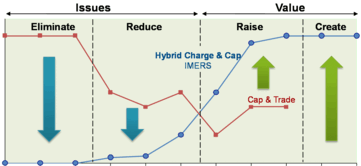Historical
Historical content refers to IMERS generations 1 and 2.
The first generation, created in 2007, introduced the idea of simultaneously addressing shipping emissions and climate financing through a fund. It was based on a charge or levy on shipping emissions, linking the levy to an emission target or cap, and direct collection of the levy from ships. This was referred to as a cap-and-charge or hybrid scheme, in various submissions and reviews (IMO 2007b, IMO 2008b, UNFCCC 2008, Faber and Rensma 2008, Stochniol 2008).
The second generation, created in 2008-2009, implemented differentiation based on final destination of goods aiming to address concerns of developing countries. It also linked the levy to an external carbon price rather than a cap on emissions. Furthermore, it provided options to make the proposal more politically acceptable to some developed countries, including an option of collecting the levy as a pre-payment in a country that may not agree to a global levy collection (Haites 2008, Stochniol 2009a, GLCA 2009, QinetiQ 2009).
The third generation, in 2009-2010, created and integrated the rebate mechanism, thus replacing the complex differentiation based on final destination of goods. It also implemented a price ceiling and floor for the levy, and simplified fuel consumption reporting, among other improvements outlined above (IMO 2010a, IMO 2010b, IMO 2010c, ICTSD 2010).
Costs and Benefits
Combining mitigation with reducing the financing gap for adaptation to climate change through a cap-and-charge scheme is effective and efficient. It can be shown through a value innovation canvas.
Value Innovation of IMERS compared with Cap & Trade for Shipping
- IMERS is an efficient alternative to emission trading and delivers:
- Maximum efficiency with minimum rate
- Near-term emission reductions, AND stimulation of longer term technology innovation & transfer
- AND reduces the adaptation financing gap by $4bn/pa WITHOUT constraining economic growth!
The costs are as low as $1 for $1,000 of imported goods, the emissions are halved and developing countries will benefit from the $4bn financing contribution for adaptation to climate change.
The details are provided in the Value Innovation, Costs, and Benefits pages below.
Value Innovation
Benefits and Costs are directly related to Value Innovation of IMERS. It is perhaps best shown using the framework from the Blue Ocean Strategy.
Charge-and-Cap (IMERS) vs Cap-and-Trade for Shipping
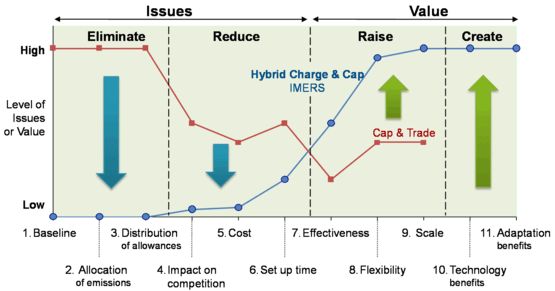
The novel charge-and-cap scheme employed in IMERS is compared above with a traditional cap-and-trade emission trading scheme for shipping. The major value contributions in IMERS comes from:
- Eliminating:
- Baseline Data (need for it)
- Allocation of emissions
- Distribution of allowances
- Baseline Data (need for it)
- Reducing:
- Impact on Competition
- Cost (including participant's cost and effort)
- Set up time (down to 2 years)
- Impact on Competition
- Raising:
- Effectiveness
- Flexibility
- Scale (from Regional to Global)
- Effectiveness
- Creating:
- Technology financing (for near- and long-term improvements)
- Financial Contributions to Adaptation to Climate Change
- Technology financing (for near- and long-term improvements)
Please note that our hybrid scheme is also known under two other names: cap-and-charge, charge-cap-and-trade.
Scheme Costs
Minimizing costs is crucial as international transport is key for trade and sustainable development. IMERS, a cap-and-charge scheme, will be significantly cheaper than cap-and-trade.
Selecting an ambitious yet affordable scheme & cap
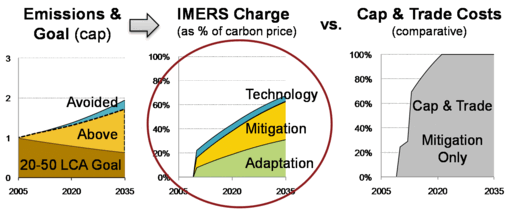
Importantly, IMERS will simultaneously deliver significant innovative financing for adaptation to climate change in developing countries and financing for technology R&D and transfer!
The proposed scheme is economically efficient and operational costs are kept low thanks to a centralized approach. The overall impact on end user prices is estimated at $1 for $1,000 of imported goods, i.e. around 0.1% (equivalent to increase of shipping costs by around 3%).
This is contrasted with the high costs for a hypothetical Cap-and-trade for shipping. For the above comparison, we have used the just announced parameters for the EU ETS for 2013-2020 (see section on Auctioning: 60% auctioning from 2013 onwards, etc).
The level of charge depends on ambition defined by a notional emission cap. Even for an ambitious 20-50 cap from 2005 the IMERS approach is easily affordable while delivering mitigation, adaptation and technology funding (as shown above).
IMERS Cost Impact
We calculate that using a harmonized charge of under $10/tCO2, would suffice from 2010-2012 (equivalent to 30% of the forward carbon price of around $30/tCO2). This translates to $30/ton of fuel.
Detailed cost calculations and impact are provided in the table below for charges as % of carbon (CO2) market price, and impact on: fuel prices, shipping costs, and end customer.
|
Year |
% of C$ |
$/t fuel* |
Shipping $ |
Customer |
|
2012 |
30% |
$27 |
2% |
< 0.1% |
|
2020 |
46% |
$42 |
3% |
< 0.1% |
|
2035 |
70% |
$64 |
5% |
< 0.2% |
*For market data: $30/tCO2, $500 t/HFO.
Finally, administrative costs for the participating ship managers is very low. The total reporting effort is expected to be under 20 minutes per month for the submission of a consolidated report on fuel used by all the ships under management. If that approach proved unworkable for some ship managers or sections of shipping, an alternative approach based on the Bunker Delivery Notes (as required by MARPOL Annex VI) will also deliver low cost.
In summary, the hybrid scheme can be ambitious and affordable, while being achievable in short-term.
Benefits
We estimate that the combination of the market mechanism, additional technical and operational industry improvements, including the mitigation programmes paid for by a portion of the funds raised, will reduce the emissions by 0.5% to 0.8% annually till 2050 (dependent on the split of funds). The total emission impact till 2100 would be more than halved due to the reduced growth and the effect of bringing forward step changes by up to 10 years.
Simultaneously, developing countries will benefit from the adaptation financing and the shipping industry from the improvements in the sector.
- Benefit details are provided for:
- Environment
- Developing countries
- Shipping
Environment
Environmental benefits are measured in emissions avoided within and mitigated outside of the shipping sector, expressed in GtCO2.
The table and picture below provide the estimates of the significant benefits of IMERS.
|
By 2050, GtCO2 |
2051-2100, GtCO2 |
|
|
Emission avoidance: |
12 |
40 |
|
Emission mitigation (offset): |
18 |
24 |
|
Total environment: |
30 |
64 |
The picture shows the mid-2007 calculations. In Dec 2007 the IMO estimated the emissions at around 1GtCO2 for 2005, effectively doubling the previous estimate. Therefore the numbers should be multiplied by 2.
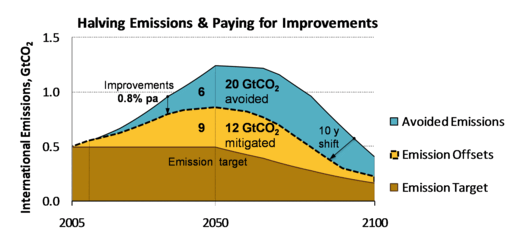
Developing Countries
Benefits to developing countries start with the common but differentiated responsibility principle comprehensively fulfilled, at both collection and distribution points.
The scheme is also
- both global (as per the IMO)
- and differentiated (as per the UNFCCC) in that the regime applies only to the emissions associated with cargo destined for Annex I Parties (in the current regime)
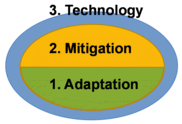
- The benefit areas for developing countries include (assuming that only emissions attributable to Annex I countries are in scope):
- Adaptation: Major funding for adaptation to climate change in developing countries
- Estimated at $2.5bn+ per annum (assuming equal split of funds between mitigation and adaptation, and carbon market price of $30/tCO2)
- This innovative approach to reduce the gap in financing of adaptation seems essential. Thus far the international community has promised approximately $200m for adaptation measures, but the required funds are estimated at tens of $billions (circa 100:1 gap ratio)
- Estimated at $2.5bn+ per annum (assuming equal split of funds between mitigation and adaptation, and carbon market price of $30/tCO2)
- Mitigation: Significantly increased demand for REDD, CDM & JI projects
- The additional global demand estimated in excess of 150MtCO2 in 2012
- The current oversupply of CDM/JI drives the prices down, while lack of major funding does not stimulate REDD
- The additional global demand estimated in excess of 150MtCO2 in 2012
- Technology benefits
- Significant increase in financing of maritime R&D, estimated at $1bn (stimulation of innovation globally)
- Transfer of technologies to developing countries
Shipping
- The business benefits of IMERS include:
- Hassle free solution for CO2 emissions with minimal administration costs (no allowances to manage, no individual cap to comply with, services provided, no set-up costs)
- No impact on international competitiveness (level playing due to global implementation)
- Increased cash flow (EBIDTA) as a result of improved operations and reduced fuel
- Reduced risk of fuel disputes
- Compliance easily verifiable (via fuel and voyage data, and analytical tools)
- Reduced risk of multiple regulations
- Benefits of better image (clean transport, social responsibility)
Climate change action makes good business sense
FAQs
Frequently Asked Questions and Answers about the differentiated IMERS
Please note that some of the FAQs have not been updated to reflect the "refund" version submitted to the UNFCCC, yet.
In the refund version the levy is uniform, applies to all ships, on all routes. Instead of the more complex differentiation by final destination of goods, the same effect is obtained through a refund to developing countries. The refund is calculated in relation to a country's share of worldwide imports.
Q 1: Does IMERS actually cap emissions?
A cap on emissions is an integral part of the scheme and applies to total CO2 emissions subject to the regime. Achievement of the cap is the key objective of the scheme. This cap is not further divided into individual country obligations, or caps.
The volume of projected emissions above the agreed cap together with the prevailing market carbon price dictates the level of the levy (emission charge). Collected at this level, the levy would generate enough money to offset the emissions above the cap.
Emission reductions are therefore guaranteed, albeit not necessarily in the shipping sector. The collected money is spent on reducing emissions elsewhere. These reductions are most likely to be outside the shipping sector due to lower abatement costs in the power generation sector, and similar. If a deficit appeared in a given year for whatever reason, the levy is adjusted upwards the following year to cover it.
Q 2: It is just a tax, isn’t it?
The employed mechanism is a hybrid quantity-price instrument, not just a tax, pure price instrument. The level of the levy is not set arbitrarily as in a tax but it is determined by the quantity goal (cap on emissions) and the prevailing market carbon price. The carbon price, created by the EU ETS and other mechanisms, in fact enables this hybrid mechanism. Without it the scheme could not exist. Secondly, the revenue raised is directed to reduce emissions as per the cap.
Furthermore, the scheme provides an option to go some way in correcting the market failure relating to the lack of adequate investments in shipping R&D for the significant emission reductions required. Additional revenue for technology research and transfer can be raised, but only if the levy is set higher than the level dictated by the emission cap and carbon price.
Some emission reductions would inevitably occur within the shipping sector driven by underlying economics. Only the remainder of reductions needed would be purchased from other sectors. How much is purchased from other sectors is driven by what is most cost efficient.
Q 3: What would be the cost impact on end customers?
It is anticipated that the impact of the scheme would only be approximately 0.1% increase in prices of imported goods to Annex I countries, despite the ambitious goal of a 20% reduction in emissions by 2020. This is equivalent to an extra $1 for every $1,000 of imported goods. There will be no cost impact on imports to developing countries.
Q 4: How much funding would go to climate change?
100% of raised financing would go to climate change. Projected funds are expected to be in excess of $6bn annually from 2013 onwards, as shown in the table below.
FUNDS (in $billions per annum) 2013 2020
Adaptation 2.5 10
Mitigation 2.5 10
Technology 1 3
TOTAL: $6bn+
Q 5: How would the funds be managed?
The adaptation and REDD+ resources would be contributed to the funds under the UNFCCC, such as the Adaptation Fund and the anticipated Forestry Fund. The technology resources would be managed through a dedicated Maritime Technology Fund (established with the shipping industry under the International Maritime Organization; or similar).
Other mitigation resources, if any, would be used to acquire emission credits through professionally managed carbon funds. This will be a part of the of the post-2012 climate change agreement.
Q 6: What would the funds be used for? Who would benefit most?
Least Developed Countries (LDCs) and Small Island Developing States (SIDS) would benefit most from the scheme due to the significant adaptation financing that would become available to them. The shipping itself would also benefit significantly due to technology funding (in $billions annually), further leveraged by private and public investments. How the funds will be split would be agreed by parties to the UNFCCC.
One potential distribution is dividing the funds into three parts: adaptation to climate change in developing countries, REDD+ (forestry), and technology in the shipping (R&D, incentives, etc.). Adaptation and forestry funding would be under the UNFCCC convention, the technology funding is proposed to be governed by the IMO & the shipping industry.
Q 7: Where does the money for adaptation come from?
The centralized approach aggregates demand for emission credits from the entire shipping sector. This would provide access to cheaper emission credits on primary emission markets (including CDM/JI) and access to government forestry schemes (REDD) at prices much lower than on the retail market. This would generate gains which are utilized to address adaptation issues, without any costs to shipping.
Q 8: How would it be implemented globally?
The simplest option is a direct payment to an emission account administered centrally. Each ship would have an account and would be liable for the levy being settled for the previous period. The account would be with the World Bank (or a selected commercial bank operating the accounts). The levy will be paid by charterers, ship-owners, ship-operators or other entities as specified in the commercial terms of the ship charter/use, in a similar way as the terms which specify who pays for fuel.
Compliance would be enforced through Port State Controls in Annex I countries only. They would have access to a central system for shipping emissions based on IMO ship numbers. There is no need to enforce the scheme in non-Annex I countries, which is an important co-benefit of the scheme as it accelerates implementation and avoids lack of capacity in some developing countries.
The governance of the funds, including a supra-national body and how the revenue would be distributed, is to be agreed within the climate change negotiations. This would be part of the overall framework for financing climate change action to be governed under the UNFCCC convention. The supra-national body is not prejudged but proposed at this stage. One reason is to assure that the funding generated is treated as additional in the meaning of the Bali Action Plan for climate change (i.e. it should be governed under the UNFCCC convention).
Q 9: How does the scheme preserve a level playing field for ships?
All ships transporting goods to any destination are treated the same, irrespective of flag they carry and the ship-owner nationality, and so on. For instance all ships delivering goods to Hamburg are treated the same and are subject to the levy. All ships delivering goods to Shanghai are treated the same (and currently would not be subject to the levy).
The level of the levy would be announced one year in advance, thus providing cost predictability and enough time for the shipping industry to incorporate the levy in their prices.
Q10: Is the scheme ambitious enough given that it may be limited to emissions from Annex I?
Please note that this Question is not relevant for the latest, refund version of IMERS.
In the refund version emissions from all ships are subject to the scheme (i.e. 100% of emissions from international shipping).
Previous version based on final destination of goods
Approximately 60% of shipping emissions are attributable to Annex I countries, based on volume of unloaded cargo. Therefore 60% of emissions will be addressed on day 1 of the scheme with an ambitious emission reduction goal – such as 20% emissions reductions by 2020 – as it would apply to Annex I countries only. The current regime does not guarantee any reductions whatsoever in the sector.
The scheme scope and cap are not independent. Expanding the scope to developing countries in a uniform manner is likely to lead to a significantly less ambitious, diluted cap. The end result might actually be the same or even worse than a scheme applied only to Annex I, not to mention being less likely to be accepted in the first place.
Objections for such a uniform scheme would stem from both sides. For instance to achieve similar total reductions as for the Annex I scheme, it would be enough for the uniform scheme to use a simple stabilization goal at the 2005 level. However simple, this goal for shipping emissions would be in our view: 1) difficult to accept in Annex I countries as not ambitious enough for the public and at odds with national targets, 2) impossible to accept in non-Annex I countries due to the principle of common but differentiated responsibilities and respective capabilities (CBDR), and the reality that greater reduction commitments and costs would be imposed on them than on developed countries.
Furthermore, IMERS can easily accommodate an important additional goal: to deviate below business-as-usual emission trajectory. This could enable some developing countries to enter the scheme. However for them the differentiated levy would be determined from the committed emission deviation and market carbon price, rather than the cap and carbon price used for developed countries. This would increase the ambition of the scheme further. Inclusion of such a deviation commitment in any cap-and-trade scheme seems rather complex, if not impossible.
Q11: How the levy is calculated?
The levy would be established at the rolling average of the carbon market price, adjusted for any prevailing free allowances. In short, shipping industry would be subject to the same carbon price as other industries; no more, no less.
Until a global carbon price emerges, the rolling average of the largest economy-wide emission reduction scheme, adjusted for any free allowances existing in the scheme, is proposed (likely to be the USA market).
Pre-refund version
The above price linkage is preferred since 2009.
The old version of deriving the levy from an emission cap is described below (for historical reasons).
The level of the levy, in this older version, was derived from the projected gap between emissions and the cap, as shown below. E is the projected emissions, and C is the cap for the total emissions. R is the ratio equal to the percentage of emissions that are above the cap, calculated as R = (E – C ) / E. In the simplest case R defines the level of levy in terms of the carbon price. The levy can be adjusted upwards for an extra charge for technology R&D.
Furthermore, both E and C can be expressed in reference to emissions in any given year – such as 2005 – through an appropriate growth rate. R can therefore be calculated from an emission growth rate for E and an emission reduction rate for C. This allows the scheme to start operating without the a priori knowledge of total emissions, in contrast to cap-and-trade for which reliable emission data is required to allocate emissions.
Example calculations for 2013. Emissions (E) and cap (C) are projected to be 116% and 89% of emissions in 2005, respectively. The ratio (R) is calculated as 23%. An adjustment of +7% for technology and scheme costs brings the levy to 30% of carbon price (wherein the carbon price is not adjusted for any free allowances).
NOTE: Please note that in a "USA linked" version of IMERS the levy could be set through a different mechanism. This is a subject of consultations starting in early 2009 (in the context of the recent proposal for an economy-wide cap-and-trade scheme in the USA). Please contact us if you require further details.
Q12: Have the calculations taken the impact of the current recession into account?
In the refund version, the calculations are based on the USA estimated carbon price of circa $15 per ton of CO2. Therefore they implicitly include the impact of the current recession.
No discount for free emission allowances has been applied.
Historical calculations
For the previous version with a global cap, the following sample costs and benefits calculations for 2013 took account the impact of the recession. The annual net emissions growth rate has been discounted to 2% per annum due to the current global slowdown (this is equivalent to skipping one year of growth and using the most conservative previous growth scenarios). An illustrative cap is set at an ambitious 20% reduction in emissions by 2020 from its 2005 level. It applies only to emissions attributable to Annex I countries (current climate change regime). Total baseline emissions in 2005 are rounded to 1 GtCO2, as per the higher estimates and for ease of scaling. Based on the emission growth rate and the emission cap, the levy is calculated as 30% of the carbon price in 2013, translating to approximately 5% of the fuel price.
Q13: Given that ships would not obtain emission allowances which they could sell if unused, is it an efficient scheme?
The scheme is economically efficient; trading occurs between different sectors: those which can make emission reductions cheaply and those which can’t. The shipping sector would be the net buyer of emission allowances/credits from other sectors for the foreseeable future. These purchases would cover the reductions they cannot make cost-effectively themselves and would be purchased centrally from the funds aggregated in the scheme (purchased from the power sector, REDD, CDM/JI, etc.). The shipping industry will also have an increased incentive to become more fuel-efficient, as the total levy paid is directly linked to the amount of fuel used. The trading aspects of IMERS, its links to emissions trading schemes have been independently analyzed and endorsed.
The incentive for selling unused allowances depends on the cost of their acquisition, and may not exist in reality. The only cap-and-trade scheme with relevant details in this area is METS, introduced by Germany for furthering discussions on the topic. In METS, emission allowances are auctioned and none are allocated for free (see IMO GHG-WG 1/5/7). Therefore the incentive from selling unused allowances does not exist as the price of selling would equal the acquisition price (either at auction or from the carbon market).
Q14: Extra data seems required. Isn’t it too complex?
The fuel data is available from the already obligatory fuel receipts (so called Bunker Delivery Notes).
That's enough.
In the new refund version, no extra data is required.
Previous alternative based on final destination of goods
The following description is shown for historical reasons. It also demonstrates the simplicity and advantages of the currently preferred, refund version.
In the previous version, the levy was only to be paid at lower than 100% level once the ship demonstrated that it was entitled to the reduced rate through the selected responsibility measure (such as the ship’s ratio of delivered cargo to Annex I countries). We understand that this single number can be extracted from the cargo data available for the ship charterers without much effort.
This additional measure will not even be required for many ships. The majority of oil tankers and cargo ships would pay either 100% or 0% in a given period, as they are typically bound for a single destination, either to an Annex I or non Annex I country/countries (for instance a tanker chartered to transport crude oil from the Gulf to the USA).
For container ships, the responsibility measure could be the share of full containers destined to Annex I countries (expressed in TEUs). This information is available from the systems operated by the liners, as the destination of container is practically always known. For the very limited number of “ghost containers”, this loophole is expected to be fixed in the near future, mainly for supply chain security reasons. Implementation for liners would be made easier thanks to the high use of ICT systems and very high concentration in the sector (16 companies comprise 80% of the sector).
Q15: How does IMERS compare with a cap-and-trade scheme then?
Given that any market-based scheme for shipping would need to be applied globally in order to be effective, its design viability and flexibility should be the key evaluation criteria. The design should accommodate the highly complex and dynamic nature of the shipping industry. The following graph illustrates a comparison of IMERS with a potential cap-and-trade. The hybrid cap-and-levy scheme employed in IMERS:
- Eliminates the three central barriers associated with cap-and-trade (emission baseline, allocation of emissions, and distribution of allowances);
- Reduces the negative impact of several key implementation issues (impact on competition, cost, and set up time);
- Raises value (in terms of effectiveness, flexibility, and scale);
- Redeploys resources saved to create new value (through technology and adaptation financing).
Q16: Would it be legal and comply with trading rules?
Given that international emissions occur mostly outside of national jurisdictions, the Law of the Sea (UNCLOS) is seen as a firm legal framework for the supra-national approach proposed (derived from articles 89, 136, 137, and 140, among others).
The supra-national approach has also an important decision making benefit. It does not raise questions regarding ear-marking (hypothecation) of a national revenue for specific causes in several countries. Supra-national revenue would always be off national books.
Furthermore, the International Oil Pollution Compensation Funds (IOPC Funds) provide a precedent of direct collection of a levy that bypasses national systems in the maritime sector. The IOPC levy is based on a formula, which is also important from a legal standpoint.
Finally, as the levy would be driven by a market-based formula, and ultimately paid by the importers without discriminating against any exporting countries, it would be compliant with both WTO and GATT rules.
Q17: What is the risk of inaction?
The risk of inaction is twofold: repeat Kyoto’s failure to address maritime emissions, and fail to provide additional financing for adaptation to climate change crucially needed for the most vulnerable.
GbD Principle & Policy
Global but Differentiated means:
Common but Differentiated (UNFCCC) applied Globally to shipping
- Any market-based instrument to address Greenhouse Gas Emissions (GHG) from international maritime transport shall be both global (as per the IMO) and differentiated (as per the UNFCCC).
- The proposed principle is called global but differentiated.
- It is for market-based schemes and instruments only, and therefore it does not apply to technical and operational measures.
- It does not prescribe any specific policy or instrument. Instead, it enables identification of the most appropriate instrument by unlocking the current multilateral impasse.
- It is for market-based schemes and instruments only, and therefore it does not apply to technical and operational measures.
PLEASE NOTE that during 2009 a new application of the principle above was created. The new concept was based on a rebate mechanism, and was well received by a number of countries. In this version, a developing country is entitled to an unconditional rebate equal to its cost burden from the scheme. It is proposed to calculate the rebate in proportion to a country's share of global (seaborne) imports. Since negotiations in Bangkok, Oct 2009, this is the preferred version. The differentiation based on final destinations of goods will be implicitly delivered through the refund. As some countries could forego the rebate, and be internationally credited for such action, the new version is much more flexible.
Due to pressure of negotiations some information on this website does not fully reflect this preference yet.
Please bear with us, we are focusing on making the proposal a reality not on publicity.
The 2008 proposal is also available as a document: Global but Differentiated Principle and Policy ![]()
The key is to agree the GD principle while understanding that a viable policy delivering on the principle exists.
Global but Differentiated Policy (Yes, it is viable)
- A differentiation policy based on cargo imported is proposed. It is to apply to all ships, irrespective of flag or nationality.
- Only two destinations are defined:
- Annex-I countries, and
- Non-Annex I countries.
- Annex-I countries, and
- Destinations are treated as per climate change regime in force. Currently it means:
- Annex I destinations are included fully.
- Non Annex I destinations are not included.
- Annex I destinations are included fully.
- A ship transporting goods to both Annex I and non-Annex I countries is partially included.
- It is included in proportion to the ship’s share of goods unloaded in Annex I countries (destined to Annex I for transhipments).
- This means that only the Annex I’s share of ship’s CO2 emissions is in scope.
- Worldwide, the Annex I share of unloaded goods is 60%. Therefore on day one of a scheme driven by such a policy 60% of maritime emissions will be covered.
Advantages
- There are three major advantages of the proposed policy:
- It will deliver on the nine principles proposed at the IMO for global approach to GHG emissions;
- It is compliant with the current and future climate change regimes;
- Environmental results will be very high as the goal may be more ambitious as it applies to Annex I only.
Scheme Details
 To tackle the complex issue of GHG shipping emissions a new International Maritime Emissions Reduction Scheme (IMERS) is proposed.
To tackle the complex issue of GHG shipping emissions a new International Maritime Emissions Reduction Scheme (IMERS) is proposed.
The proposed scheme is global in order to maximise economic efficiency and avoid competitive issues of regional and national schemes. Specifically it is flag neutral. It is also differentiated as per the climate change regime and UNFCCC principles.
It addresses both emission mitigation and adaptation to climate change, including funding for transformational technology changes.
NOTE: The recent refund version, submitted at the Barcelona Climate Change Talks 2009" - is not fully reflected on these pages, yet.

Long-term Cooperative Agreement (LCA) for international shipping
The outcome of the scheme depends on the long-term cooperative agreement (LCA) for maritime contributions to the climate change action. Anticipated funding for the three goals together with the operational costs are shown in the table below for the LCA driven by a notional goal "20-50 from 2005 level" (reduce emissions 20% by 2020, and 50% by 2050 from the emission level in 2005). Carbon prices used: $30/tCO2 in 2012, $60/tCO2 in 2020. Emission baseline in 2005: 1GtCO2. Annual net emission growth: 2.1%/pa.
|
FUNDS per annum |
2012 |
2020 |
|
Technology |
$2bn |
$4.6bn |
|
Mitigation |
$4bn |
$15bn |
|
Adaptation |
$4bn |
$15bn |
|
Operational Costs |
$0.7bn |
$1.3bn |
- a working 1-page example

- a supporting document with main details
 (0.1 MB)
(0.1 MB)
Note that the recent estimates for emissions from shipping have doubled from a year ago!
Two historical summaries as prepared for the IMO MEPC 56 session in July 2007 are available:
Goals
The ambition is to Halve Maritime Emissions & Pay for Improvements needed in one cohesive supra-national scheme while addressing differentiated priorities from the developed and developing countries.

- The goals are:
- Mitigate the maritime GHG emission growth through the most cost effect measures and halve the emissions over long-term;
- Reduce the gap in financing for adaptation to climate change in developing countries (in $bn annually);
- Provide a global approach leading to agreement within the next 2 years.
The emission reductions will be achieved through near-term technical and operational industry improvements and by accelerating long-term step changes.
The scheme minimizes the administration burden and costs for ship owners, since it is a centralized system. It also avoids two major obstacles: unreliable emission baselines and allocation of emissions from international bunker fuel to countries.
Outline
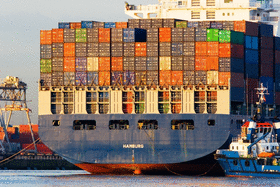 We propose that CO2 emissions from international maritime transport are treated on international level rather than being allocated to countries. An emission reduction goal (cap) is established and applies to all destinations with emission reduction commitments (currently Annex I countries). An emission charge is established. It is linked to the goal and the prevailing forward carbon price. Aggregated funds from the emission charges are used to both stimulate innovations and cost-effectively mitigate growth of maritime emissions. Furthermore, $billions of gains generated through the aggregated approach are directed to climate change adaptation in developing countries.
We propose that CO2 emissions from international maritime transport are treated on international level rather than being allocated to countries. An emission reduction goal (cap) is established and applies to all destinations with emission reduction commitments (currently Annex I countries). An emission charge is established. It is linked to the goal and the prevailing forward carbon price. Aggregated funds from the emission charges are used to both stimulate innovations and cost-effectively mitigate growth of maritime emissions. Furthermore, $billions of gains generated through the aggregated approach are directed to climate change adaptation in developing countries.
Global but Differentiated
The scheme is therefore both global (as per the IMO) and differentiated (as per the UNFCCC). It applies to all ships irrespective of flag and nationality, and fulfils the principle of common but differentiated responsibilities and respective capabilities. See the proposed Global but Differentiated principle.
Implementation
IMERS would implement a charge on the CO2 emissions from international shipping based on fuel use and cargo destination. Fuel data will be extracted from obligatory fuel receipts (called Bunker Delivery Notes). Alternatively, ship managers could report fuel use for voyages ended during the previous month. The emission charge (fee) would be announced at least one year in advance to allow passing on the charges to end customers. The fees would be paid by the fuel payers, typically charterers, typically monthly. The emission charges are differentiated as per the climate change regime in force, based on destination of cargo. Under the current regime, ships transporting goods to:
- Annex I countries pay 100% of emission charges
- Non-Annex I countries pay zero;
- Both types of countries pay on average 60% of emission charges (variable multiplier).
The liable entity is ship, and the scheme is enforced through port state control in Annex I countries.
Distribution of Funds
The charges raised would go to a supra-national fund established under the UN (under the IMO or the UNFCCC) and be used to:
- Invest in maritime technology transfer and stimulate longer term technology transformation;
- Purchase CO2 credits equal to the actual emissions in excess of the established emissions cap; and
- Contribute to climate change adaptation in developing countries.
Costs
A fee of US$9 per tonne of CO2 would bring about $6 billion annually from 2012 and raise shipping costs by circa 3% (to Annex I countries). This is equivalent to an extra $1 for every $1,000 of imported goods to Annex I countries. There is no impact on imports to non-Annex I countries.
The fee (a unit emission charge) is calculated in advance based on the prevailing forward carbon market price and a negotiated emission goal. This makes the proposed cap-and-charge an alternative to cap-and-trade, avoiding the barriers of emission trading (such as emission allocation and distribution of emission allowances).
Hybrid scheme: cap-and-charge
The scheme therefore is a hybrid one, both from the economics and goals points of view. It combines in a single scheme:
- a quantitative goal (cap) with a price instrument (charges): a “cap-and-charge”;
- emission mitigation, adaptation to climate change and technology action;
- differentiated responsibilities and capabilities, of countries and individuals.
The name does not really matter as long as the scheme can efficiently deliver the notional emission target (cap) at an affordable price ...
Not tax
The fee is not a levy or a tax set at some arbitrary level. The goal (cap) together with the market (via the market price for carbon) dictates the level of the fee, rather than a single body that may be subject to outside influence. The example $9 fee was calculated for 2012 assuming 2.1% rate of emission growth, emission goal of reducing emissions by fifth by 2020 from 2005 level, and a carbon market price of $30/tCO2.
Governance
Organisation: We propose establishing a multilateral Governing Organization (GO) within the UN system. The GO will be an execution organization with parameters provided for. It will be responsible for collection and disbursements services for international maritime CO2 emissions. The emission reduction goal and how the revenue is further divided will be decided by the Conference of Parties (COP). The emission charge will be set through a formula linking the emission reduction goal, emission growth and prevailing market price for carbon.
Adjustments to New Realities.
- Periodic governance mechanisms would allow for adjustment of charges and funding policy to new realities.
- Every 4-10 years the UNFCCC in consultation with the IMO should undertake a review and potential adjustment of the emission reduction goal, and the funding priorities (this may include relative size of the mitigation, adaptation and technology funds).
- Every year the body should undertake a market price review and setting of the new emission unit charge.
Administrative Procedures
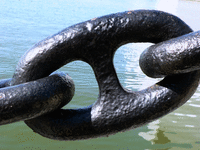 NOTE: 2007 version described. (improvements added in 2008 version)
NOTE: 2007 version described. (improvements added in 2008 version)
The description below is for the 2007 version. After recent consultation a simplified version is now preferred based around fuel delivered and the bunker delivery notes (BDN). BDNs are already required by the MARPOL Annex VI. The 2007 description has however an advantage of allowing to fully implement an IMO CO2 index. Furthermore, the 2008 Autumn version differentiates between Annex I and non-Annex I destinations to deliver on the UNFCCC principle of common but differentiated responsibilities (CBDR).
Data collection. We propose that ship managers submit a fuel used record to the scheme database for the recent voyages once a month, along with the volume of work and distance travelled for all ships under their management.
Monitoring and reporting. For monitoring and subsequent reporting the emissions are calculated by the scheme based on amount of voyage fuel used and type of vessel/engine, using appropriate emission factors (tier 2 methodology as per IPCC, 2006 Guidelines for National Greenhouse Gas Inventories).
Verification. Accounting and verification for the central organization will be subject to ISO 14064 standard for greenhouse gas accounting and verification. Electronic verification of fuel reports might be augmented in certain cases with the ship log verification by an authorised official at any port participating in the scheme.
Enforcement.
- It is proposed to enforce the compliance in selected ports for:
- Provision of relevant data for the most recent voyages;
- Payment of the emission charges for the period ending three months earlier (or similar).
Additional details are available in the presentation on IMERS data requirements
- They were discussed at the Technical workshop on Emissions from aviation and maritime transport, Oslo, Norway, 4-5 Oct 2007. The report and presentations from the workshop are available externally:
- workshop report by IISD
- workshop presentations
Synopsis
Practicability and Attractiveness
NOTE: Theses synopsis relate to the 1st generation of IMERS. The 3rd generation changes, including the rebate mechanism, are not reflected in the description below. These are provided for historical reasons.
The details of the scheme are provided below using two main criteria: Attractiveness and Practicability. Lessons learned have proved that successful schemes must combine policy appeal and economic efficiency with reliable data and feasible implementation. With some additional political will, the scheme can be operational even before 2012.
The mid-2007 IMERS synopsis, 1st generation ![]() (0.1 MB) used at the UNFCCC COP 13 in Bali meeting are included for comparison (note that the COP13 synopsis were based on the mid-2007 estimate of shipping emissions of around 0.5GtCO2; current estimates are double of that).
(0.1 MB) used at the UNFCCC COP 13 in Bali meeting are included for comparison (note that the COP13 synopsis were based on the mid-2007 estimate of shipping emissions of around 0.5GtCO2; current estimates are double of that).
Practicability
|
Scheme Design |
|
|
-- (None1; using the UNFCCC SBSTA option 1 – no allocation) |
|
-- (None needed) |
|
Fuel payers for charges; ship managers and/or suppliers for reporting |
|
Direct electronic; compliance enforced in selected ports, both for the provision of data (such as BDN) and payment of charges |
|
Implementation Feasibility |
|
|
Emission growth: available |
|
Fuel data, used or delivered: available (starting with Bunker Delivery Notes, BDN) |
|
Voyage data for validation; CO2 index from real data once the scheme operates, used as a performance measure for ships, routes etc. |
|
IMO for governance; World Bank, or similar, to manage adaptation funding (recommended Adaptation Fund under the UNFCCC) |
|
Scheme Parameters |
|
|
Yes; enclosed calculations done for notional reductions of 20% in 2020, and 50% in 2050 from 2005 level |
|
Baseline not needed, and avoided as it is currently commercially inadequate. |
|
Bubbles for containers, bulk, tankers, etc., could further improve the scheme equity and speed up implementation |
|
2 years – could be operational BEFORE 2012 |
Attractiveness
|
Scope and Goals |
|
|
Worldwide |
|
All vessels > 400 GT |
|
Global, or per vessel bubbles (containers, bulk, tankers, …) |
|
Adaptation to climate change in developing countries |
|
International, CO2 only at the beginning |
|
Political Appeal |
|
|
Through financing policy for adaptation; differentiation at point of distribution rather than collection |
|
None in sector; negligible outside shipping |
|
A hassle-free long-term solution, increased cash flow, compliance easily verifiable, long term investment clarity, better image of shipping |
|
Could be under MARPOL; IOPCF - a precedent for a direct fund; aviation route charges as an example of delegating collection and billing responsibility to a central organisation (Eurocontrol in Europe) |
|
Costs |
(for 2010, key assumed prices: fuel $500/tHFO, carbon $30/tCO2) |
|
Low: 0.1%, equivalent to adding $1 to price of $1,000 of imported goods |
|
Negligible (20 minutes reporting time for ship managers per month) |
|
$10/tCO2 or $30/tFuel (linked to emissions and carbon price) |
|
Under 5% (a centralized solution; operational ratio higher in the initial years) |
|
Effectiveness |
(assuming 1GtCO2 baseline in 2005; for others – multiply results by the respective baseline value in GtCO2 |
|
$4bn/pa; Total mitigation of 26 GtCO2 by 2050 (30% of it is emission avoidance) |
|
+0.5% annually, $2bn/pa Technology Fund, for transformational R&D and technology transfer |
|
$4bn/pa, for developing countries (likely as contribution to the UNFCCC Adaptation Fund) |
|
Only parties that legally support the scheme are eligible to participate in the scheme benefits (adaptation, technology and so on) |
|
Cost-effective through usage of carbon markets, and a dedicated maritime emission registry |
|
Flexibility |
|
|
CDM, CERs without limits; also programmatic CDM for increased quality |
|
Applies to both existing and new ships; no problems with including new entrants as scheme is based solely on charges, rather than allowances |
|
Charge annually; funding policy reviewed and adjusted periodically by IMO |
|
Can be limited to ship type or size threshold; easy scaling up thanks to the harmonized charge that does not vary with the number of participants |
1 The scheme avoids the complex problem of allocating emission allowances to countries, flags, routes or ships, and associated issues, such as lack of a reliable emission baseline, high transaction costs for small emitters etc. It achieves an emission cap on shipping emissions through a hybrid price-quantity mechanism that is linked to established emission markets, thereby delivering the reduction in the most cost effective manner.
Solution Base
 The scheme complies with calls from China, India, Least Developed Countries (LDCs), and other countries. The concept has received political support in the IMO from around three dozen states, and led to various other proposals.
The scheme complies with calls from China, India, Least Developed Countries (LDCs), and other countries. The concept has received political support in the IMO from around three dozen states, and led to various other proposals.
It will deliver the 4 major blocks from the Bali Roadmap in the following way:
- Mitigation --> halving emissions from international maritime transport, in longer term
- Adaptation --> reducing the gap in adaptation funding by $4bn+ annually; could be operational from 2013
- Technology Transfer & Innovation --> through a new Maritime Technology Fund
- Adequate & predictable funding --> Funds from emission levy/charge, set well in advance, by a fair formula; circa $10bn annually (from developed countries only, as developing countries are entitled to receive rebates)
Importantly, the scheme is based on solid foundation that include:
Business
Design of IMERS has been strongly influenced by strategy and management best practices as well as lessons learned from development of large scale market-places.
The transaction costs are minimized by applying centralized solutions and eliminating intermediaries that do not add value.
Unnecessary or low-quality data are eliminated, cost of compliance and effort of end user are limited to minimum. Elements that add value are raised. Adaptation funding and Technology Fund are created as new features within the overall low cost.
This is shown in outline below using the framework from the Blue Ocean Strategy.
Value Innovation of IMERS compared with Cap & Trade for Shipping
For more details see Value Innovation section.
Climate Change Diplomacy (2008)
Rapid progress in tackling climate change requires innovation both in solutions and diplomacy.
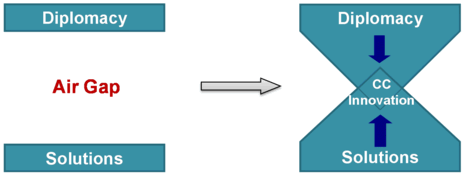
See our case study on innovation in Climate Change Diplomacy ![]() (0.5MB), as presented in Malta.
(0.5MB), as presented in Malta.
The topic was discussed at the International Conference on Climate Change Diplomacy, Malta, 7-8 February 2008, organised by DiploFoundation ![]() .
.
- All sessions were on climate change diplomacy and covered:
- What's different
- A multi-stakeholder approach
- Regional perspectives
- Building Capacity (see conference programme and presentations).
Case Study: Innovation in Climate Change Diplomacy
Rapid progress in tackling climate change requires innovation both in solutions and diplomacy
IMERS innovation case study ![]() (0.5MB presentation)
(0.5MB presentation)
This case study shows how diverse and conflicting positions in climate change negotiations can be addressed successfully through simultaneous innovation in solutions and the diplomatic process. The potential for synergies is enormous as many officials are constrained by bureaucracy and time, and often lack the vision and skills that business innovators can bring.
We describe how novel thinking and non-state actors have managed to unlock one of the most methodologically complex and diplomatically difficult issues. Emissions from international aviation and maritime transport had to be excluded from the Kyoto Protocol in 1997 and little progress has been achieved since then.
In early 2007 we created an ambitious International Maritime Emission Reduction Scheme (IMERS). It is a novel market-based scheme to mitigate maritime CO2 emissions and simultaneously reduce the gap in financing of adaptation to climate change in developing countries by $3bn annually (from 2010, assuming 2005 emission goal). Within just one year it was brought to the International Maritime Organization (IMO), discussed internationally and followed by practical submissions from various states and organizations. We will discuss how this swift progress was possible, what issues have been unlocked, and what remains to be done for the proposed scheme to be agreed and implemented.
Our experiences show that bringing novel solutions by non-state actors to diplomatic negotiations requires business rigour and diplomatic patience, as well as money - obtaining funding for a public good solution is rather difficult!
Based on our experiences, we find that successful innovation in climate change diplomacy involves three crucial steps:
- Craft an ambitious yet affordable solution. Do it by following best practices in business strategy, thereby avoiding governmental or other policy constraints.
- Bring the proposal to the multilateral process through an influential government. Ignore the temptation to try to achieve this through associations or large companies, it might take years.
- Engage relevant parties in an iterative process aimed at refining and ultimately supporting the proposed solution. Select diverse parties for initial discussions - obtaining support from the 27 EU countries is well short of what is required in climate change diplomacy. Formalize this iterative process within the multilateral organization and engage business innovators in the process.
The case study ends with an open discussion drawing on the key lessons learned. Example quotes from informal discussions in 2007 to enrich the debate:
- I've only 2 hrs per week for this topic.
- Why us? Why not country XYZ?
- After so many years of deadlock I don't even remember what's the issue anymore
- Seems like a great proposal. But, it might be incompatible with our policy.
- Q: What's your policy?
- A: We don't have one yet.
- Our experts are uncomfortable.
- Q: What about?
- A: I don't know yet.
Economics
Cap-and-levy
IMERS uses a novel hybrid economic instrument that we call cap-and-levy
(it was presented by Norway and others as a hybrid scheme, and was also called cap-and-charge; some people use the name charge-cap-and-trade to signify the trading aspect of the instrument).
A levy (emission charge) is established in such a way that an agreed emission target (cap) will be delivered for international shipping by purchasing emission credits if required.
- The cap-and-levy is:
- Using a carbon price established by the large emitting industries;
- Delivering quantity target through a "clearing house" for a sector or its part - a bubble.
GHG Policy Options
Cap-and-levy is an example of GHG policy that has the highest theoretical cost-effectiveness. The different GHG policy options are shown below, ordered from the highest to the lowest cost effectiveness.
- Hybrid quantity-price
- Tax or charge
- Cap-and-trade with banking, borrowing, and allocation auctioning
- Traditional cap-and-trade scheme
- Non-market regulations and standards
Ethical
The ethical arguments for polluters to pay for emissions are well established.
The most recent negotiations in Bali during the UNFCCC COP 13 have also shown the acceptance that developed countries should compensate the developing countries for the harm done. The current increased level of CO2 in the atmosphere is due to the growth and decades of prosperity of developed countries.
The starting point for IMERS was the recognition that mitigation and adaptation are both important, and that the UNFCCC principle of 'common but differentiated responsibilities' can be delivered in a novel way for international shipping.
IMERS has therefore been designed to fulfil on the following five principles:
- Will contribute fairly to the ultimate objective of the UNFCCC in accordance with its provisions
- In particular the principle of 'common but differentiated responsibilities and respective capabilities', and take into account social and economic conditions and other relevant factors
- Will conform to policies and measures of sustainable development
- Equal attention will be paid to mitigation of emissions globally and adaptation to climate change in developing countries
- Technology innovation, transformation and transfer will be comprehensive
- Will contribute to a shared vision for long-term co-operative action, and will be build around a long-term goal for emission reductions
Note: There is a growing literature on the ethical aspects of climate change, including on the responsibility of governments to tackle the threats and impacts of climate change. One of the web-sites dedicated to the topic is: climateethics.org.
Legal
Legal basis for IMERS, including the proposed differentiation, comprise:
- UNCLOS convention defining the rights and responsibilities of nations in their use of the world's oceans
- IOPC Funds precedent for direct funding
- WTO rules that do not contradict a harmonized emission charge
- GATT rules allow emission charges based on imports
- MARPOL convention that could cover GHG emissions
UNCLOS
The United Nations Convention on the Law of the Sea (UNCLOS) defines the rights and responsibilities of nations in their use of the world's oceans
. It codifies the principle of international customary law.
- All waters beyond national boundaries are considered international waters — free to all nations, but belonging to none of them.
Dominance of International Law
UNCLOS aims to balance interests of international community and global commons, and therefore codifies the dominance of international law over national law in respect to the high seas.
The following articles are most relevant: 89 (invalidity of claims of sovereignty over the high seas) , 136 (common heritage of mankind), 137 (legal status of the area).
Regarding air pollution the following articles are most relevant: 212, 222.
Supra-national Approach and Equity
Although, UNCLOS does not explicitly regulate equitable division of revenues raised from international emission charges proposed it provides a very relevant analogy. The analogy are minerals discovered in the sea bed under the high seas, which are outside the sovereignty of any country. The revenue from exploitation of these minerals should be distributed equitably (article 140: Benefit of mankind).
In summary:
UNCLOS provides a firm legal framework for a supra-national approach proposed.
IOPC Funds
Within maritime industry there is already a legal precedent for a supra-national fund organization. The International Oil Pollution Compensation Funds (IOPC Funds) are three intergovernmental organisations which provide compensation for oil pollution damage resulting from spills of persistent oil from tankers. The organisations are: the 1971 Fund, 1992 Fund and the Supplementary Fund.
The importance of the precedent is that the contributions to the funds are direct, bypassing the national systems, thereby avoiding the so-called "domestic revenue problem".
WTO
World Trade Organization (WTO) and the UNFCCC have sustainable development as one of their objectives:
WTO, preamble
“Recognizing that their relations in the field of trade and economic endeavour should be conducted with a view to […] allowing for the optimal use of the world's resources in accordance with the objective of sustainable development, seeking both to protect and preserve the environment and to enhance the means for doing so in a manner consistent with [members’] respective needs and concerns at different levels of economic development”
Cross-references to International Trade in the Climate Change Regime
UNFCCC, art. 3(5):
“The Parties should cooperate to promote a supportive and open international economic system that would lead to sustainable economic growth and development in all Parties, particularly developing country Parties, thus enabling them better to address the problems of climate change. Measures taken to combat climate change, including unilateral ones, should not constitute a means of arbitrary or unjustifiable discrimination or a disguised restriction on international trade.”
A good source for materials and/or advice on the WTO aspect, if one still has doubts about the legality of harmonized charge as proposed, is the Centre for International Sustainable Development Law in Montreal, Canada.
GATT
General Agreement on Tariffs and Trade(GATT) prohibits differentiated treatments of goods based on their country of origin. As the proposed emission charges are not linked to the country of origin and to any specific goods directly, they conform with the GATT rules.
The conformity is achieved without the need to refer to the article XX that allows exemptions on the grounds of environmental protection.
MARPOL Annex VI
The International Maritime Organization (IMO) develops and promulgates international regulation on air emissions from shipping.
- MARPOL 93/97 Annex VI was ratified in 2004, and entered into force on 19 May 2005.
- Regulation 13 of Annex VI applies to emissions of nitrogen oxides (NOx)
- Regulation 14 applies to sulphur oxides (SOx)
- Regulation 15 applies to the emission of volatile organic compounds (VOCs)
- Regulation 18 addresses fuel oil quality, particularly record keeping, fuel sampling and the issue of Bunker Delivery Notes (BDNs).
A summary of the process and options being considered is available from IPIECA as document Maritime air emissions and MARPOL Annex VI
GHG addition to MARPOL Annex VI
The most straightforward approach to implement technical parts of legislation on the GHGs from shipping would therefore be to extend Annex VI for CO2, as the major GHG emitted by shipping. Time to enter into force of such amendment is likely to be 16 months. A route through a new convention would take many years.
Including CO2 or selected GHGs within Annex VI has the additional advantage of reuse of other regulations, notably the regulation 18 on BDNs.
